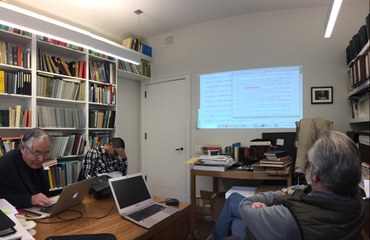The Gārgīyajyotiṣa is thought to be one of the oldest, if not the oldest astronomical/omen text from ancient India. The work has been considered an important authority on the astral science from as early as the time of the Mahābhārata. Western scholars since the 19th century have noted its importance but no one has yet completely edited and studied the text. This prompted David Pingree a few decades ago to call the editing of the Gārgīyajyotiṣa as a task “most urgent”.
In 2016, a few scholars including myself: Bill Mak (Kyoto University, Japan), Marko Geslani (Emory University, US), Yano Michio (Kyoto Sangyo University, Japan), Kenneth Zysk (Copenhagen University, Denmark), Koji Kumagai (Tohoku University, Japan), formed a “Gargasaṃhitā Workgroup,” with the intention to produce a complete edition of the most ancient and complete version of the text (identified by Mitchiner and Pingree as G1 or the Gārgīyajyotiṣa). We have met once in New York earlier this year to discuss of the way to proceed, as each of us has a different specialization:

Editing of the Sanskrit manuscripts of the Gargasaṃhitā (28 February, 2017)
Our preliminary research result, titled “Garga and early astral science In India” is currently in print, and shall be available freely online in the next issue (2017/2018) of the journal of History of Science in South Asia, where you will find some recent and important articles related to ancient Indian astronomy and astral science:
I have recently presented an academic paper titled “Tithikarmaguṇa in Gārgīyajyotiṣa – Tithi worship according to a number of early sources” which shall be published next March (2018). I discussed the concept of tithi as presented in the Gargasaṃhitā, possibly the earliest reference to tithi in our extant Sanskrit source. I also revisited Neugebauer and Pingree’s idea that tithi comes from Babylonia. The questions whether there are Hellenistic and Babylonian materials in early Indian jyotiṣa and to what extant they influenced later Indian astral science cannot be settled until the text of Garga is properly transcribed, edited, translated and studied.
Currently, I am planning a trip to India this coming January, 2018, Ito collect the key manuscripts in Calcutta, Varanasi, Bombay and some other archives in Rajasthan and Gujarat. Beside Garga, I hope to find more Yavana manuscripts hidden in archives and monasteries throughout India.
Further progress on the editing and publication of various chapters of the Gargasaṃhitā will be reported next year in a special panel which I helped to chair during the upcoming World Sanskrit Conference to be held in Vancouver, Canada (July 9-13, 2018):
I hope there will many scholars, especially those from India will attend this important event, especially in our section where we hope to hear about the latest works from the frontier research in the ancient history of science – medicine, astronomy, geology, chemistry in India.
Here is my workbench at my Kyoto office where I am putting together a critical edition of the first few chapters of the Gārgīyajyotiṣa, with eight manuscripts I have on hand: A, Bh, E, F, G, H. M, P. Very exciting work!

